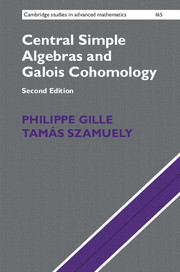Book contents
- Frontmatter
- Contents
- Preface
- 1 Quaternion algebras
- 2 Central simple algebras and Galois descent
- 3 Techniques from group cohomology
- 4 The cohomological Brauer group
- 5 Severi–Brauer varieties
- 6 Residue maps
- 7 Milnor K-theory
- 8 The Merkurjev–Suslin theorem
- 9 Symbols in positive characteristic
- Appendix: a breviary of algebraic geometry
- Bibliography
- Index
5 - Severi–Brauer varieties
Published online by Cambridge University Press: 07 August 2017
- Frontmatter
- Contents
- Preface
- 1 Quaternion algebras
- 2 Central simple algebras and Galois descent
- 3 Techniques from group cohomology
- 4 The cohomological Brauer group
- 5 Severi–Brauer varieties
- 6 Residue maps
- 7 Milnor K-theory
- 8 The Merkurjev–Suslin theorem
- 9 Symbols in positive characteristic
- Appendix: a breviary of algebraic geometry
- Bibliography
- Index
Summary
In Chapter 1 we associated with each quaternion algebra a conic with the property that the conic has a k-point if and only if the algebra splits over k. We now generalize this correspondence to arbitrary dimension: with each central simple algebra A of degree n over an arbitrary field k we associate a projective k-variety X of dimension n − 1 which has a k-point if and only if A splits. Both objects will correspond to a class in H1(G,PGLn(K)), where K is a Galois splitting field for A with group G. The varieties X arising in this way are called Severi–Brauer varieties; they are characterized by the property that they become isomorphic to some projective space over the algebraic closure. This interpretation will enable us to give another, geometric construction of the Brauer group. Another central result of this chapter is a theorem of Amitsur which states that for a Severi–Brauer variety X with function field k(X) the kernel of the natural map Br (k) → Br (k(X)) is a cyclic group generated by the class of X. This seemingly technical statement (which generalizes Witt's theorem proven in Chapter 1) has very fruitful algebraic applications. At the end of the chapter we shall present one such application, due to Saltman, which shows that all central simple algebras of fixed degree n over a field k containing the n-th roots of unity can be made cyclic via base change to some large field extension of k.
Severi–Brauer varieties were introduced in the pioneering paper of Châtelet [1], under the name ‘variétés de Brauer’. Practically all results in the first half of the present chapter stem from this work. The term ‘Severi–Brauer variety’ was coined by Beniamino Segre in his note [1], who expressed his discontent that Châtelet had ignored previous work by Severi in the area. Indeed, in the paper of Severi [1] Severi–Brauer varieties are studied in a classical geometric context, and what is known today as Châtelet's theorem is proven in some cases. As an amusing feature, we may mention that Severi calls the varieties in question ‘varietà di Segre’, but beware, this does not refer to Beniamino but to his second uncle Corrado Segre.
- Type
- Chapter
- Information
- Central Simple Algebras and Galois Cohomology , pp. 139 - 162Publisher: Cambridge University PressPrint publication year: 2017



